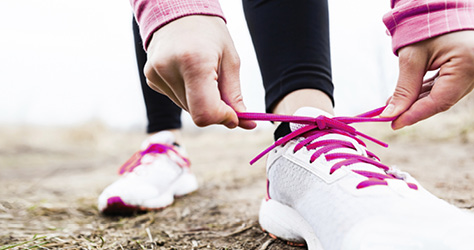When can you swim again? How soon can you start aerobics? And do you really need pelvic floor exercises? Here’s some advice on exercising after your baby is born.
If you’re worried you still look pregnant several weeks after the birth, you’re not alone. Very few post-birth tummies spring back to their former glory instantly – despite magazines full of pictures of stick-thin celebrities three weeks after having a baby.
Look at it this way: it took nine months for your body to prepare for the birth, so it’s going to take more than a couple of weeks for your body to recover. Lots of mums say it takes six to nine months before their body is back to normal.
You’ll want to concentrate on your baby in the early months and not worry too much about your weight or your saggy stomach. But a bit of gentle exercise can lift your mood and actually give you more energy. Here’s how to get started:
At a glance
- The most important exercise to start with is your pelvic floor exercises
- Aim to get out in the fresh air and walk with the pram every day
- Once you’ve had your post-natal check at six weeks, you can go swimming again

Early days
Only one exercise is essential for now: pelvic floor exercises. Your pelvic floor muscles hold the bladder, womb and lower bowel in place and they’re weakened by pregnancy and labour. That’s why you may leak urine when you jump, sneeze or laugh. This happens to around half of new mums. Don’t worry if you didn’t do pelvic floor exercises in pregnancy: you can make up for it now. Aim to start them as soon after the birth as you feel comfortable. Here’s how:
- Gradually tighten the muscles you use if you want to stop the flow of urine; pull them in and up. Try to do it without holding your breath, squeezing your buttocks together, or pulling in your tummy muscles. Hold the squeeze for several seconds and then relax slowly.
- Now pull the muscles up tight and fast. Then relax. Then tighten them quickly again. This exercise is for the ‘flick’ muscles of your pelvic floor.
- Do this several times a day in batches of five or six. Try to make them a routine because ideally, you’ll do them regularly for the rest of your life. To help you remember, try doing them while carrying out another task you do regularly such as making a cup of tea or brushing your teeth.
Weeks 1-6
Aim to get out in the fresh air and walk with the pram every day. It will lift your mood, tone muscles, burn calories and it’s also good for your baby to get outside. You could even join a ‘power-pramming’ class in the local park with other mums. Don’t do any strenuous exercise yet, though, especially if you didn’t exercise in pregnancy or had a difficult labour.
From week 6
Once you’ve had your post-natal check at six weeks, you can go swimming again (there’s a risk of infection before six weeks). Many pools offer post-natal and baby swimming classes and you don’t need to wait until their immunisations at two months. You could also join a post-natal exercise class with your baby (lots of leisure centres and gyms offer these).
From week 12
You can do a bit more now, although if you’re not used to exercise, take it slowly and carefully. Your joints and ligaments will still be loose and prone to damage for three to five months after the birth. Gentle aerobic exercise is fine now, though save the high impact classes for another few months. You can also do weight-bearing work in the gym (always tell the instructor/personal trainer you’ve just had a baby). Yoga and pilates are really effective for building core strength and tummy muscles; look out for specialist post-natal classes. Really strenuous work-outs can alter the taste of your milk, so keep it gentle if you’re breastfeeding and get a really supportive bra. If you were a keen runner or sportswoman before your pregnancy, and also kept fit all the way through pregnancy, it’s safe to go back to your sports around 3-4 months. But if you’re not used to strenuous exercise, best to wait a couple of months longer and build it up gradually to avoid injury.